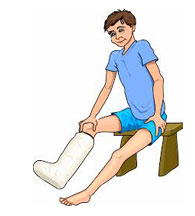 | Page 21 of 25 |  |
FRACTURE

A fracture is a broken bone. It requires medical attention. If the broken bone is the result of a major trauma or injury, call 911 or your local emergency number. Also call for emergency help if:
• The victim is unresponsive, isn't breathing and isn't moving. Begin CPR if you are CPR certified or if you are familiar with CPR techniques.
• There is heavy bleeding.
• Even gentle pressure or movement causes severe pain.
• The limb or joint appears deformed.
• The bone has pierced the skin.
• The extremity of the injured arm or leg is numb or bluish at the tip.
• You suspect a bone is broken in the neck, head or back.
• You suspect a bone is broken in the hip, pelvis or upper leg.
Symptoms of a fracture are:
• Out-of-place or misshapen limb or joint
• Swelling, bruising or bleeding
• Intense pain
• Numbness and tingling
• Limited mobility or inability to move a limb
Take these actions immediately while waiting for medical help:
• Stop any bleeding. Apply pressure to the wound with a sterile bandage, a clean cloth or a clean piece of clothing.
• Immobilize the injured area. Don't try to realign the bone.
• Apply ice packs to limit swelling and help relieve pain until emergency personnel arrive. Don't apply ice directly to the skin, wrap the ice in a towel, piece of cloth or some other material.
Treat for shock. If the person feels faint or is breathing in short, rapid breaths, lay the person down with the head slightly lower than the trunk and, if possible, elevate the legs.
 | Page 21 of 25 |  |




